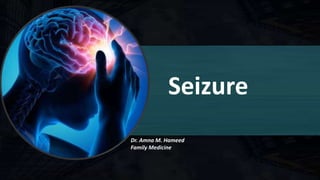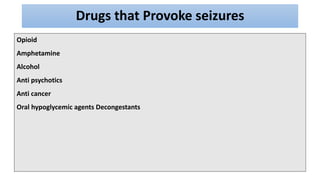This document discusses seizure disorders. It defines a seizure as excessive electrical activity in the brain that can cause abnormal movements, behaviors, sensations, or loss of awareness, depending on the involved brain regions. Seizures can be provoked by insults like metabolic disturbances or substance withdrawal, or unprovoked. The pathophysiology involves an imbalance between excitatory and inhibitory forces in neuronal networks. Evaluation involves a detailed history, exam, EEG, imaging, and labs to diagnose epilepsy or another condition. Management focuses on controlling seizures with antiepileptic drugs while minimizing side effects and maintaining quality of life.





































